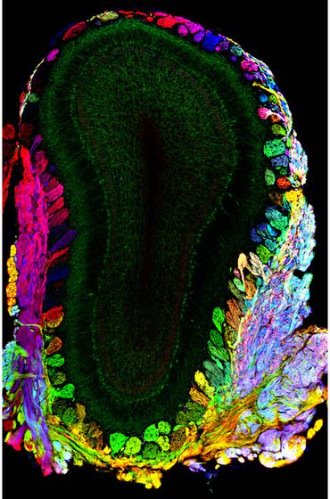Aug. 1, 2008 Research Highlight Biology
Wired for smell
Brain scientists unlock the combination of molecules used to connect up the olfactory system
 Figure 1: The location of BIG-2-linked glomeruli (red) in the olfactory bulb compared with two other guidance molecules (blue and green). Reproduced with permission from Ref. 1 © 2008 Elsevier Inc.
Figure 1: The location of BIG-2-linked glomeruli (red) in the olfactory bulb compared with two other guidance molecules (blue and green). Reproduced with permission from Ref. 1 © 2008 Elsevier Inc.
Japanese researchers have unraveled details of the molecular guidance system that ensures the sensory nerves of the smell or olfactory system are correctly wired into the brain. A set of guidance molecules steers the developing nerve process or axon growing from the cell body of an olfactory sensor neuron (OSN) to a spatially specific globular tangle of axons known as a glomerulus in the olfactory bulb (OB). The smell sensor is connected through the glomerulus to the central nervous system.
This targeting system looks to be similar throughout the body’s sensory systems and many of the same molecules are employed. Deleterious mutations in the genes of these guidance molecules can result in incorrectly wired sensory systems with serious developmental consequences.
Earlier work by many different research groups had shown that each OSN carries only one type of smell receptor. The axons from cells of the same receptor-type converge on a few spatially fixed glomeruli on the surface of the OB.
In order to find out more about how this targeting was achieved, researchers from RIKEN’s Brain Science Institute in Wako worked with a molecule known as BIG-2 found on the axons of some mouse OSNs. In a recent paper in Neuron1, they report finding that BIG-2 was associated with a small range of specific olfactory receptors. On the OB, axons carrying BIG-2 on their surface connected strongly to one group of glomeruli, weakly to another group, and not all to a third group in a mosaic pattern. There appeared to be no correlation between this binding pattern and those of other axon targeting molecules (Fig. 1). And in mice genetically engineered to lack BIG-2, the axons usually associated with BIG-2 linked to glomeruli outside the normal fixed positions.
When the researchers considered the results of their work together with studies into similar systems in zebrafish, they proposed a four-step hierarchical model for the establishment of nerve circuitry in the olfactory system—the initial outgrowth regulated by one set of molecules; navigation towards the OB by another; targeting to the appropriate district of the OB by a third; and then the final convergence onto specific glomeruli which is governed by combinations of several guidance molecules, including BIG-2.
“We now want to trace the connections from the olfactory bulb deeper into higher olfactory centers of the brain, and begin to relate the whole system to olfactory-mediated behaviors,” says project-leader Yoshihiro Yoshihara.
References
- 1. Kaneko-Goto, T., Yoshihara, S., Miyazaki, H. & Yoshihara, Y. BIG-2 mediates olfactory axon convergence to target glomeruli. Neuron 57, 834–846 (2008). doi: 10.1016/j.neuron.2008.01.023
